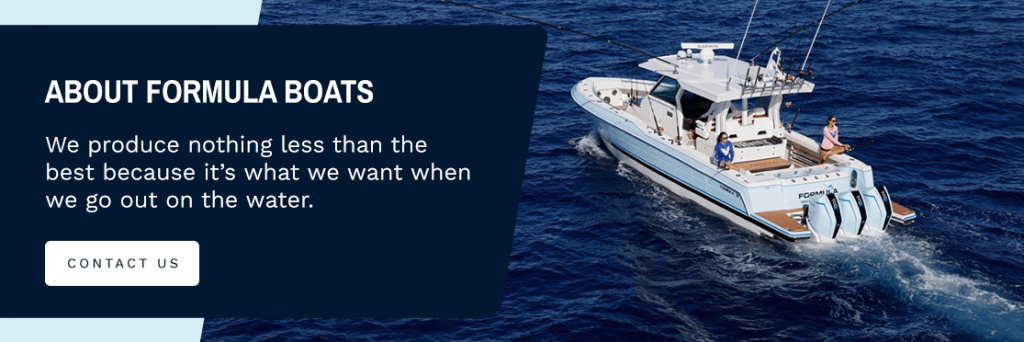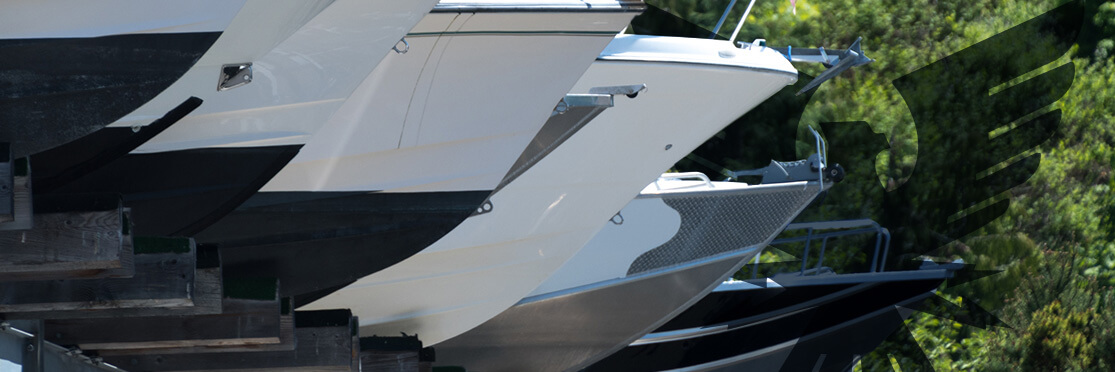
Although some of us may want to be on the water every day, weather and life have other plans. If you’re ready to join the 11.77 million registered boat owners in the United States, you may have some questions about where to store your boat.
When you have to store your boat for short or long periods, there are several different ways you can do it — it all depends on where you live, your budget and what storage options are available to you. It also depends on the method of storage you prefer as well as whether you’re looking for short-term storage or winter storage for several months.
In this quick guide, we’ll go over some of your boat storage options and help you find the one that’s best for you.
Storing a Boat Outside
Probably the most popular choice across the United States is to keep your boat outside. Boat owners choose this option if they plan on going long periods without using their vessel and because it’s the most cost-effective.
Let’s get into the types of outdoor boat storage and their pros and cons.
1. Parking Your Boat on Your Property
If you have room on your property and your homeowner’s association allows, some owners choose to store their boats at home on a trailer. It makes it easy to work on your boat, and you don’t have to drive to a storage facility to pick it up.
It’s not for everyone and not best for every type of boat, though. Unless you have a small boat or a large piece of property and space from neighbors, you’ll probably want more room.
Pros
- You don’t have to pay storage fees.
- Getting to your boat is easy, and you can hitch up quickly.
- You can keep an eye on your boat yourself.
Cons
- Neighbors and homeowner associations may not allow this option.
- Your boat is still outside and exposed to more elements than indoor storage.
- If you live in a high-traffic area, your boat could be at risk of burglary.
2. Outdoor Boat Storage as a Self-Storage Facility
If you’re lucky enough to live in an area where winter never gets too harsh, you may want to opt for an outdoor self-storage facility to store your boat. While these facilities are usually the most cost-effective option, they still offer better security than storing your boat on your property.
Pros
- These facilities are the most cost-effective, especially for larger boats that would otherwise have high slip fees.
- Security systems and guards help dissuade people from messing with your boat.
Cons
- Even with a good cover, your boat will still be exposed to the elements to some degree.
- These facilities can sometimes have rodent problems, and curious raccoons and mice can make themselves at home in your boat during the offseason.
3. Covered Boat Storage at a Self-Storage Facility
A step above completely exposed storage facilities, covered storage lots are still accessible and allow you to keep your boat more protected from the elements. These facilities can usually accommodate boats of all sizes and are also a good choice if you have limited space on your property.
While they’re still technically outdoors, these types of storage offer structural shelter from sun and rain and are a good in-between option for those looking for a little more protection.
Pros
- More protection from outdoor conditions than only your boat’s cover.
- Most facilities have a surveillance system, and your boat won’t be exposed to as much foot traffic as in a neighborhood.
- These types of facilities can be less expensive than entirely indoor boat storage options.
Cons
- Without full indoor storage, your boat is still somewhat exposed to outdoor conditions.
- These types of facilities are not everywhere, and there may not be one close enough to where you like to boat to be worth the other benefits.
Outdoor Boat Storage Tips
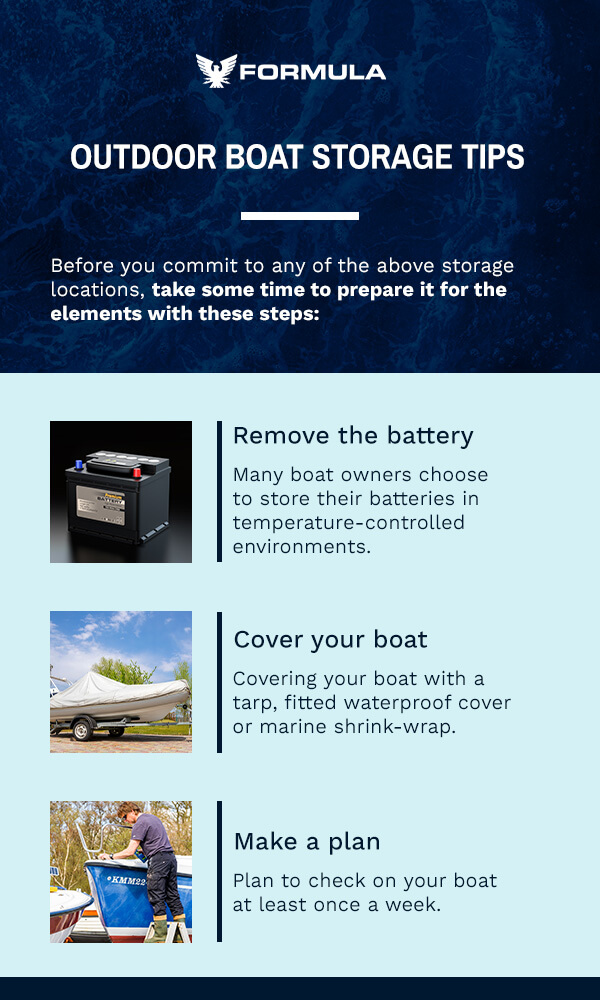
You need to know how to store a boat outside to protect it from the elements, especially if you’re planning on keeping it in storage over the winter.
Before you commit to any of the above storage locations, take some time to prepare it for the elements with these steps:
- Remove the battery: Many boat owners choose to store their batteries in temperature-controlled environments, like their homes, to prevent corrosion and other damage. You might also consider placing your battery on a trickle charger over the winter to ensure it maintains its charge.
- Cover your boat: Covering your boat with a tarp, fitted waterproof cover or marine shrink-wrap will keep moisture and mildew from damaging your boat’s interior.
- Make a plan: If you’re storing your boat at an outdoor facility, plan to check on your boat at least once a week. While these facilities include onsite security in your storage fees, regular visits can help you catch potential issues before they escalate into costly repairs.
Ultimately, as long as you take the time to prepare and maintain your boat properly, outdoor storage can be a convenient, cost-effective option. However, if you have less time available to keep up with regular maintenance, you may want to consider a different storage type.
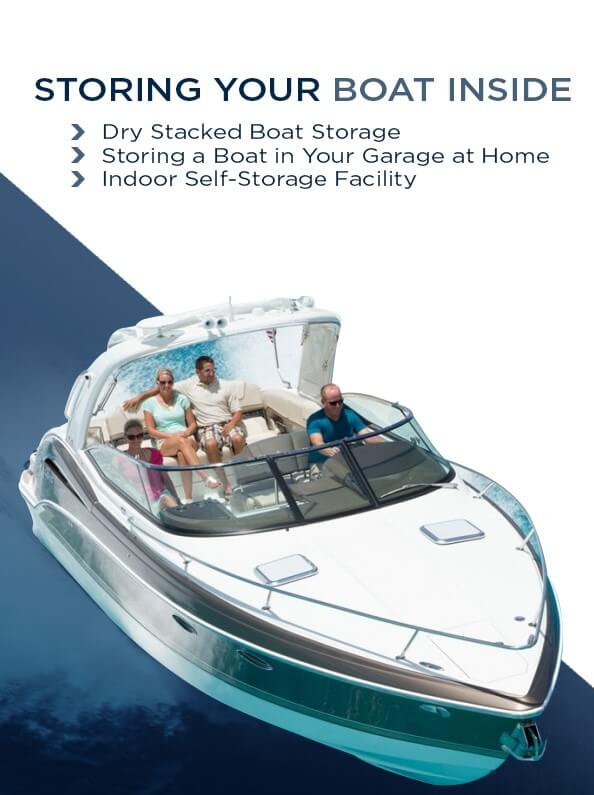
Storing Your Boat Inside
While the cost of storing your boat inside is going to be more than outside options, it may well be worth it to protect your boat. Depending on the harshness of your area’s weather, the cost you save in other maintenance because of outside storage could make up for the difference in price. Let’s take a look at the different kinds of indoor storage and their pros and cons.
1. Dry Stacked Boat Storage
Stacked storage warehouses keep your boat inside and filed away for safekeeping. They store several boats in their facilities that are stacked and moved with a series of lifts.
While your boat isn’t as accessible as it would be in self-storage, if you call ahead, these facilities are usually able to have your boat ready to go by the time you get there.
Although covered facilities protect from the outside elements, some may still experience freezing temperatures, which means you still have to winterize your boat before storage.
Pros
- Your boat is completely protected from outside conditions like UV rays, wind and rain.
- Warehouses have good security, and the stacked style of storage prevents thievery.
- You don’t have to worry about maintaining your trailer through the winter.
- It’s more cost-effective than keeping your boat in the marina.
Cons
- It’s more difficult to access your boat, and if the warehouse is busy, you may have to wait.
- Some facilities limit the number of times you can access your boat a month.
- It can be challenging to find a dry stacked facility in your area.
2. Storing a Boat in Your Garage at Home
This one is only an option with smaller boat models, of course, but if you have the organizational courage and the ability to do it, it’s a great option. Not only do garages provide the best accessibility and convenience for working on your boat, but the warmth of an attached garage can also help reduce the risk for wintertime freezing problems.
Pros
- You have easy access and maintenance through the winter and periods of non-use.
- Storage is free.
- Your boat is protected from freezing temperatures.
- Your boat is sheltered from UV damage, wind and rain.
- It’s easy to hook up your batteries to a trickle charger.
- Your garage is more secure than other outdoor storage options.
Cons
- It limits your garage space for other vehicles.
- It can make entry and exit from the garage difficult.
3. Indoor Self-Storage Facility
Warehouse-style storage facilities are excellent options if there’s one in your area. While they tend to be more expensive than the racked storage system — because they can fit fewer boats per the amount of space — the convenience and ease of access may be worth it.
Note — If your boat isn’t too big, you may be able to keep it in an individual storage unit instead of a warehouse-style facility.
Pros
- It’s easier to find this type of facility compared to some of the other types.
- You can access your boat whenever you want and don’t have to rely on the storage crew to get it.
- Security for these facilities is better than outdoor self-storage options.
- Some of the higher-end facilities have climate control for combating winter temperatures.
Cons
- These facilities are more expensive than other self-storage options.
- Sometimes, limited space may make getting a spot for a large boat difficult.
- A facility’s distance from the water can make for added time when taking your boat out for the day.
Tips for Storing Your Boat Indoors
While storing a boat indoors is typically more convenient than storing it outside, it often comes with higher prices.
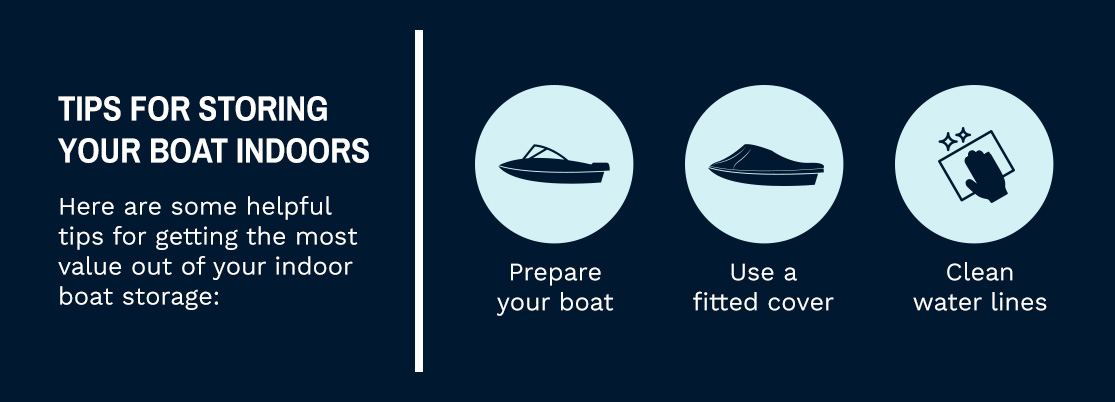
Here are some helpful tips for getting the most value out of your indoor boat storage:
- Prepare your boat: Before you store your boat, top off your gas tank, add a fuel stabilizer and disconnect the battery. Additionally, remove all valuables and personal items from your boat before you leave.
- Use a fitted cover: Even though your boat is indoors, it’s important to take precautions to prevent pests, dust and moisture from damaging your boat’s interior. You can use a fitted fabric cover or, if you’re storing it for a long period, marine shrink-wrap.
- Clean water lines: Humidity can be a concern in some indoor storage facilities, so be sure to drain your water tank and clean your sump and drain lines before leaving your boat for the winter.
Storing Your Boat in the Water
For short-term storage and ease of use, there’s no better option than keeping your boat in a marina slip. You can head down to your boat on a whim and take it out for a few hours or a few minutes, and you won’t have to deal with pulling it out of storage or using the launch ramp.
In-slip storage can be a viable option for winter, too, if your region doesn’t get below freezing. But, your boat will need regular attention and exercise through long periods of disuse to keep its systems functioning well.
Most slips are priced based on their length, and some can be quite costly depending on where you live. But if it fits into the budget and climate, we highly recommend this option to maximize your use of your boat.
Pros
- You don’t have to deal with a trailer and launching your boat.
- You save time not driving to the storage facility.
- Most marinas offer electrical hookups to keep your batteries charged and healthy.
- You can hang out on your boat in your slip for pre-voyage and post-voyage fun.
Cons
- Your boat is exposed to elements like wind, rain and UV light.
- Your boat will require routine maintenance and exercise.
- Renting a slip is often a more expensive method of storage.
- Security measures are present but often not as good as indoor storage.
- You have to protect against birds and other marine life.
- In-water boats require hull cleanings for algae and barnacles.
Storing Your Boat on a Slip Lift
If you like the idea of your boat being ready-to-go at your slip but may not want to head down to check on it very often, you may want to consider a boat lift. Lifts raise your boat up and out of the water to minimize some of the problems that come with in-the-water storage.
Lifts aren’t viable on every kind of dock and aren’t allowed in some marinas. But if it is permitted, you may want to consider it as a way to protect your vessel.
Pros
- The same benefits as keeping your boat in a slip without algae and barnacle growth.
Cons
- Installing a lift can be expensive.
- Lifts aren’t suitable for intense wind and weather climates.
Storing Your Boat With a Marina Lift Company
Some harbors have lift storage facilities that will store your boat in the marina. This is a great option to use for long-term storage and easy transfer back to your slip once the off-season has ended.
They often provide some type of coverage but are often not enclosed storage facilities, so you’ll have to protect your boat accordingly.
Pros
- It’s easy to transfer your boat from the slip into storage, as you don’t need a trailer.
- Your boat comes out of storage and goes right back into the water for minimal downtime.
- You avoid the barnacle and algae buildup on your hull from storing your boat in a slip.
Cons
- The facilities are often partially exposed, so your boat is not fully protected.
- In-marina lifts are more expensive than other inland options.
Boat Lift Storage Tips
Whether you’re storing your boat on your property or at a marina, these tips will help you ensure its safety:
- Use the proper lift: Choose a lift with a high enough capacity to support your boat for long periods. Ideally, look for one that can withstand heavier loads than what you need to give yourself a good safety cushion.
- Check lift level: If you plan to store your boat this way during the offseason, make sure the boat lift is above surface level to prevent ice and water damage to the hull.
- Inspect your lift: Regularly inspecting your boat lift once every three to five years can help you ensure everything is in working order when you need it. It can also help you resolve any minor issues that may pop up before they can escalate into more serious problems.
How to Safely Store Your Boat
Now that we’ve covered the typical types of boat storage, here are a few easy tips to help your boat smoothly transition from storage to use and vice versa.
Short-Term Storage
Your routine for preparing your boat for short-term storage can either greatly increase your boat’s longevity or the opposite. If you follow a few easy steps every time after you get done with a day on the water, your boat will continue to run and look nice for a long time:
- Rinse your boat with fresh water: The crystals left behind by dried salt water can damage your boat’s surface if you don’t wash it off after use. Rinsing with fresh water before storage can prevent these crystals from forming and keep your boat looking great.
- Flush your engine: Flushing the engine after boating in salt water helps prevent corrosion.
- Cover your boat: Even if it’s just for the rest of the day, it’s always a good idea to cover your boat to protect your upholstery and other components from damaging UV rays.
Long-Term and Winter Storage
If you’re lucky enough to live somewhere that has mild winters, you may be able to get away with storage methods that others can’t.
But if you’re putting your boat away for the winter, there are a few things you should do to protect your boat’s mechanical systems — specifically if you live somewhere that experiences sub-zero temperatures:
- Winterize your systems: The main task for preparing your boat for winter is to replace the fresh water in all of your boat’s systems with potable antifreeze — it prevents ice from forming and damaging components.
- Get a good cover: Wind and rain can batter your boat if you decide to store it outside for the winter. A tightly-fitting cover is the best defense to protect your boat. You may also consider getting your boat shrink-wrapped for the winter — it’s stronger than typical covers and is impervious to rain and wind damage.
- Protect against moisture: If you’re ever going to store your boat for an extended period, you need to make sure there isn’t any lingering moisture in the interior. Mold and mildew can form, and you’ll have to deal with them after storage.
- Remove the battery: Many marine batteries cannot be recharged if they fall below a certain percentage. While disconnecting the battery for the winter is optional, it allows you to ensure your battery maintains its charge in a temperature-controlled environment.
How Much Does Storing Boats Cost?
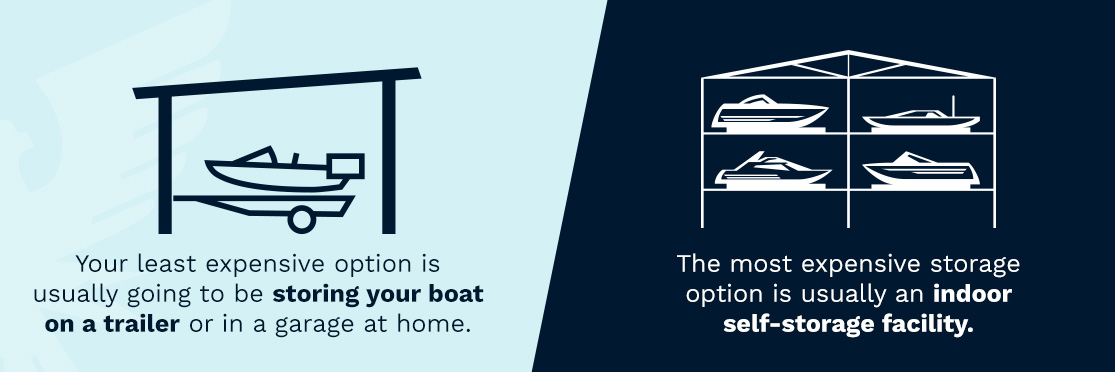
It’s difficult to give specific numbers since storage costs tend to vary widely by region and other factors. Your least expensive option is usually going to be storing your boat on a trailer or in a garage at home. While you’ll need to purchase equipment like a trailer and fitted cover, these are just one-time costs — you won’t have to pay any ongoing storage or service fees. However, you will be responsible for maintaining and securing your boat yourself.
The most expensive storage option is usually an indoor self-storage facility. In addition to managing limited space, these facilities often factor additional services into their monthly fees, which means higher costs for you.
Breaking Down Boat Storage Costs
When you know what goes into boat storage pricing, you can find easy ways to cut costs.
The biggest factors influencing boat storage costs include:
- Location: In general, the higher the cost of living in your area, the more storage facilities will charge per month. Costs will usually be highest in large cities where space is already at a premium.
- Storage type: Outdoor storage options are usually more affordable than indoor facilities because fewer additional services are included in the fee. However, you will need to spend a little more upfront on a good cover to protect your boat’s interior from water and UV damage.
- Availability: The more space a storage facility has to sell, the lower your prices will be. Generally, your rates won’t change once you’ve signed a contract — but terms can change from facility to facility.
- Boat size: Larger boats like pontoons and sport boats need more storage space, which means your monthly costs will be higher. Smaller boats can fit into tighter spaces, so storing them outside your home will usually be more affordable.
- Insurance: Storage facilities typically require that you take out a marine insurance policy and, in some cases, hull insurance. Some marinas will also specify a minimum policy limit, which can drive up costs significantly.
- Amenities: Many storage facilities include amenities like climate-controlled spaces, security detail, hauling services, pressure washing and preventive maintenance services in their pricing, which increases your monthly fees. However, many owners find that these services add value to the cost.
How to Save on Boat Storage
If keeping your boat at home isn’t an option, deciding where to store a boat for the lowest price can be difficult. Follow these money-saving tips to get the best deal at a storage facility near you:
- Shop around: Before you drop your boat off at any facility, do some research on all the options in your area. Ask about the amenities each facility provides and how much space is available at each one to get the best idea of their pricing models.
- Look for discounts: Many facilities offer discounted rates for long-term storage arrangements, so look for deals in your area.
- Commit to maintenance: Keeping your boat in good condition is one of the simplest ways to reduce overall ownership costs. Some indoor facilities will offer preventive maintenance services, while others will not.
- Budget properly: Failure to budget correctly is one of the biggest mistakes people make when buying a boat, and storage costs often contribute to this issue.
- Read the fine print: Before signing any storage facility’s contract, ensure you understand all the terms and conditions. Taking the extra time to parse through the legalese can help you avoid hidden fees later on.
No matter what storage type you choose, make sure it’s convenient for you, and always make sure your boat is properly protected and ready to get back to warm weather fun.
About Formula Boats
Formula Boats has been a family company since the Porters started running things in 1976 — that’s why we take business personally and want our customers to maximize their boating joy.
When you buy a Formula boat, you become a part of our family, and we want you to feel that way when you work with us.
We produce nothing less than the best because it’s what we want when we go out on the water. When you don’t cut corners and don’t settle, you end up with a functional, beautiful boat that’s built to last.
If you have any other questions about where to store your boat or would like to speak to one of our friendly staff about our models, please contact us today.
